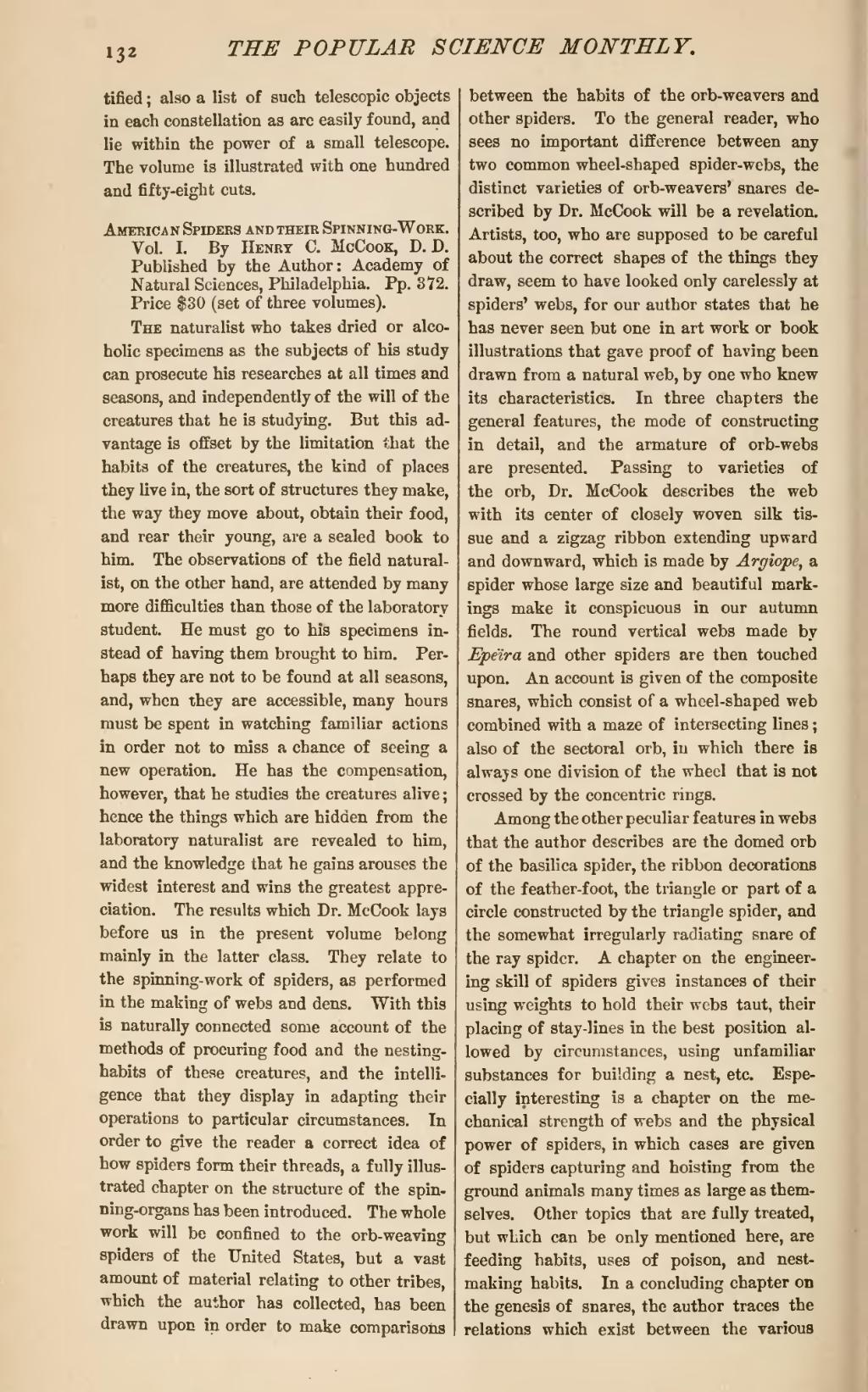ified; also a list of such telescopic objects in each constellation as are easily found, and lie within the power of a small telescope. The volume is illustrated with one hundred and fifty-eight cuts.
American Spiders and their Spinning-Work. Vol. I. By Henry C. McCook, D. D. Published by the Author: Academy of Natural Sciences, Philadelphia. Pp. 372. Price $30 (set of three volumes).
The naturalist who takes dried or alcoholic specimens as the subjects of his study can prosecute his researches at all times and seasons, and independently of the will of the creatures that he is studying. But this advantage is offset by the limitation that the habits of the creatures, the kind of places they live in, the sort of structures they make, the way they move about, obtain their food, and rear their young, are a sealed book to him. The observations of the field naturalist, on the other hand, are attended by many more difficulties than those of the laboratory student. He must go to his specimens instead of having them brought to him. Perhaps they are not to be found at all seasons, and, when they are accessible, many hours must be spent in watching familiar actions in order not to miss a chance of seeing a new operation. He has the compensation, however, that he studies the creatures alive; hence the things which are hidden from the laboratory naturalist are revealed to him, and the knowledge that he gains arouses the widest interest and wins the greatest appreciation. The results which Dr. McCook lays before us in the present volume belong mainly in the latter class. They relate to the spinning-work of spiders, as performed in the making of webs and dens. With this is naturally connected some account of the methods of procuring food and the nesting habits of these creatures, and the intelligence that they display in adapting their operations to particular circumstances. In order to give the reader a correct idea of how spiders form their threads, a fully illustrated chapter on the structure of the spinning-organs has been introduced. The whole work will be confined to the orb-weavins: spiders of the United States, but a vast amount of material relating to other tribes, which the author has collected, has been drawn upon in order to make comparisons between the habits of the orb-weavers and other spiders. To the general reader, who sees no important difference between any two common wheel-shaped spider-webs, the distinct varieties of orb-weavers' snares described by Dr. McCook will be a revelation. Artists, too, who are supposed to be careful about the correct shapes of the things they draw, seem to have looked only carelessly at spiders' webs, for our author states that he has never seen but one in art work or book illustrations that gave proof of having been drawn from a natural web, by one who knew its characteristics. In three chapters the general features, the mode of constructing in detail, and the armature of orb-webs are presented. Passing to varieties of the orb, Dr. McCook describes the web with its center of closely woven silk tissue and a zigzag ribbon extending upward and downward, which is made by Argiope, a spider whose large size and beautiful markings make it conspicuous in our autumn fields. The round vertical webs made by Epeïra and other spiders are then touched upon. An account is given of the composite snares, which consist of a wheel-shaped web combined with a maze of intersecting lines; also of the sectoral orb, in which there is always one division of the wheel that is not crossed by the concentric rings.
Among the other peculiar features in webs that the author describes are the domed orb of the basilica spider, the ribbon decorations of the feather-foot, the triangle or part of a circle constructed by the triangle spider, and the somewhat irregularly radiating snare of the ray spider. A chapter on the engineering skill of spiders gives instances of their using weights to hold their webs taut, their placing of stay-lines in the best position allowed by circumstances, using unfamiliar substances for building a nest, etc. Especially interesting is a chapter on the mechanical strength of webs and the physical power of spiders, in which cases are given of spiders capturing and hoisting from the ground animals many times as large as themselves. Other topics that are fully treated, but which can be only mentioned here, are feeding habits, uses of poison, and nestmaking habits. In a concluding chapter on the genesis of snares, the author traces the relations which exist between the various
